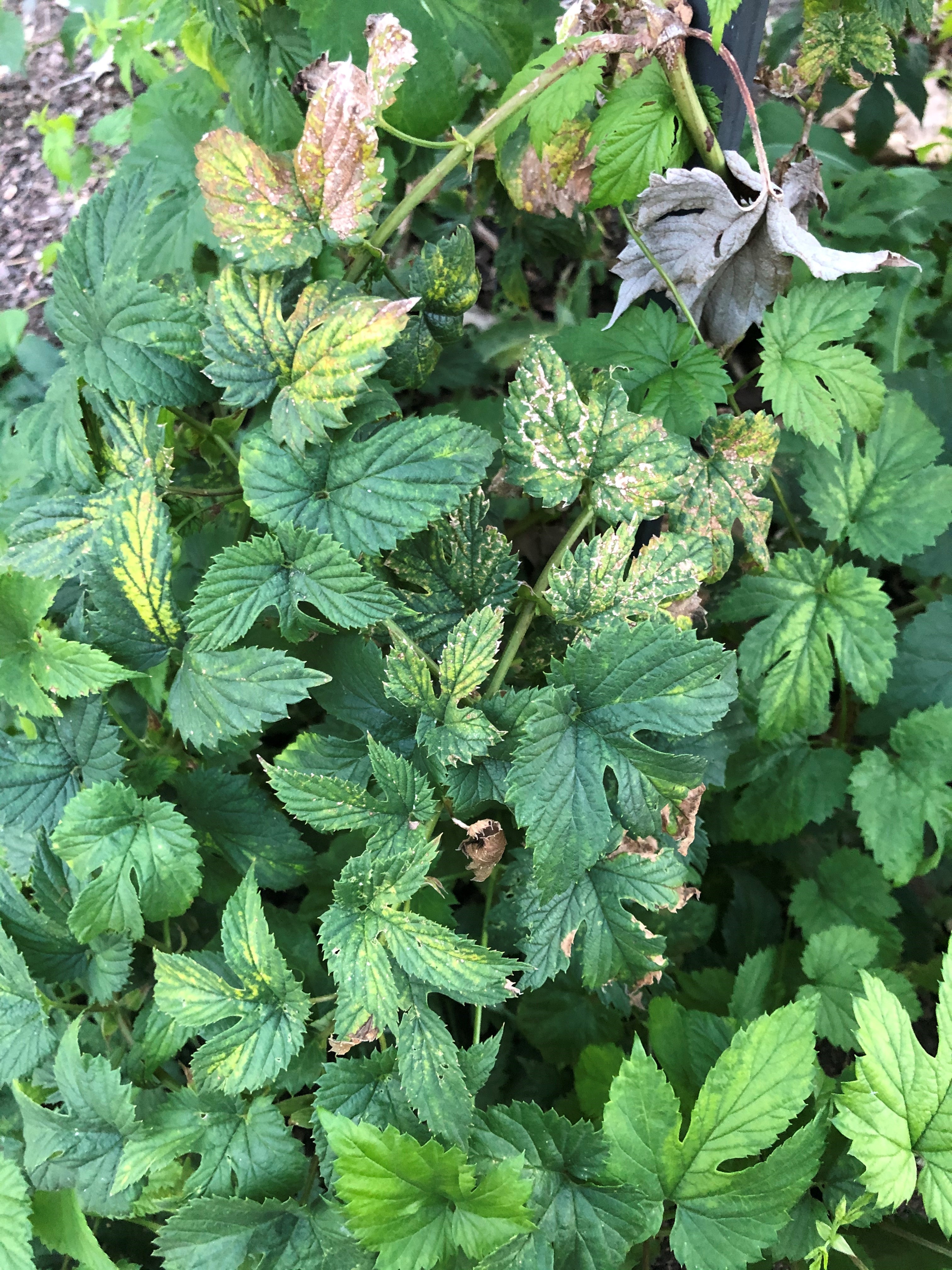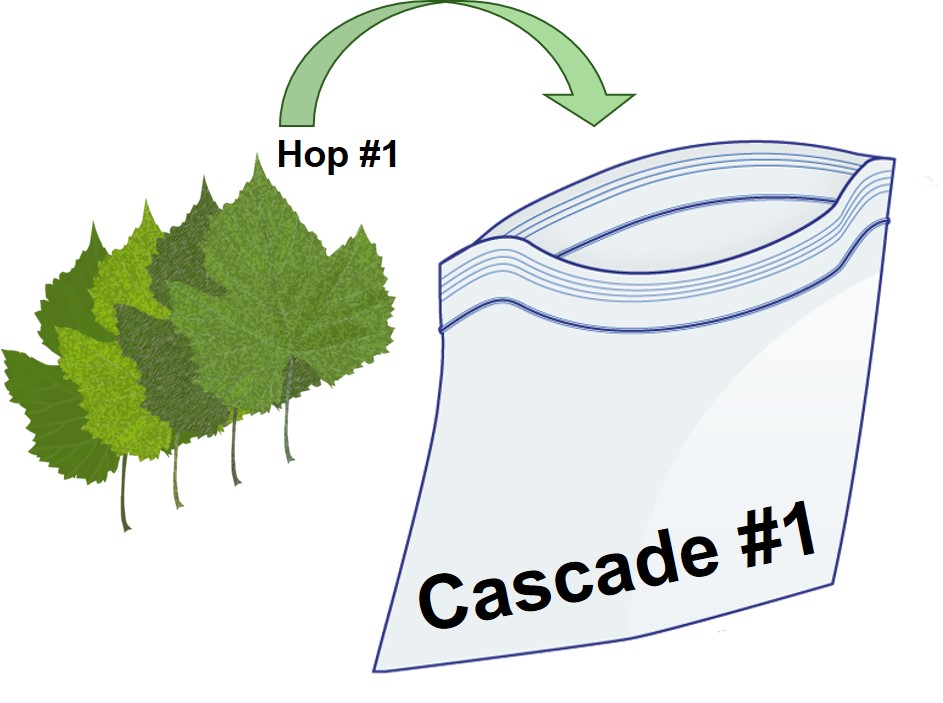MSU Plant & Pest Diagnostics provides testing for hop viruses and viroids
Available tests include three carlaviruses, apple mosaic virus, hop stunt viroid and hop latent viroid.

Hops are known to host several viruses and viroids that potentially impact profitability by reducing yield, quality and/or plant longevity. Several of these pathogens are widespread in Michigan (Photo 1) and mixed infections of multiple viruses and viroids in a single plant are frequently found (Photo 2). The perennial nature of hop and common methods of propagation contribute to the the accumulation of these pathogens over time.
The expression of disease symptoms caused by viruses and viroids depends on many factors including hop cultivar, environmental conditions, and the pathogen present. Symptoms of viral infection may be obvious or subtle, or not visible at all. Keep in mind that nutrient and water deficiencies can mimic viral symptoms and should be considered. If you suspect a virus or viroid problem on one or more plants in your hop yard, consider submitting a leaf sample for testing to Michigan State University Plant & Pest Diagnostics.

General guidelines on hop leaf sample collection
- Select and mark suspect hop plants. A suspect hop plant usually has atypical growth or performance. For example, plants may show leaf discoloration (e.g., yellowing, light-color speckles, rings, arcs) and/or growth distortions (twisted leaves, stunting, bines that fall off the strings, poor yield, etc.). Mark the plants selected for sampling until results are recieved as fit may be necessary to re-sample and re-test.
- Label sample bag. Using a black or blue permanent marker, label a gallon-size resealable plastic bag with your sample identifier. For example, "Cascade #1".
- Avoid sample cross-contamination. Our testing method is very sensitive, and so sap from an infected hop plant can compromise the test results of a healthy one.
- It is highly recommended to use disposable gloves when taking samples from more than one plant. Always change your gloves before collecting samples from a different plant.
- It is not necessary to use cutting tools for leaf collection. If you do decide to use tools, thoroughly disinfect them before collecting samples from a different plant.
- Never touch the end of detached leaves because oozing sap may spread infection.
- Use only new, clean resealable plastic bags and place the sample immediately into the bag.
- Collect living leaves with petioles, preferably in early to mid-season. Concentrations of viruses and viroids are generally higher when plants are green and actively growing, and higher in petioles and main leaf veins, where virus particles are transported. The number of leaves to collect per hop plant depends on the sampling scheme:
- Single-plant sampling
- Multiple-plant sampling
Single-plant sampling

- Reach for a full-size living leaf and pull it backwards until the petiole snaps off.
- Collect a total of four leaves from different bines and in different positions (for example, front and back) on the suspect hop plant. You can restrict the sampling to those leaves that are easiest to reach. Include both symptomatic leaves (if present) as well as asymptomatic (green) leaves.
- Stack leaves on top of each other and place them immediatly inside your labeled bag. Insert petioles first.
- Push some air out of the bag and seal it. Don’t add extra moisture (like water or wet paper towels) to the sample or it may rot in transit.
- Keep the sample cool, but not frozen, until shipment. Heat will degrade samples. Storage in a refrigerator is ideal.
Multiple-plant sampling

- For cost-savings, you may consider submitting a collection of leaves from two, three or up to four hop plants to be tested together as a single unit. This combination of individual samples is called a composite sample and can facilitate screening of a greater number of plants. However, keep in mind that under some circumstances the sensitivity of tests of composite samples may be lower, due to the dilution of the signal. In other words, there is a greater chance of failing to detect an infection if it is present in only one of several plants tested together. For circumstances where the greatest diagnostic certainty is required, suspected plants should be sampled separately.
- Samples from individual hop plants are collected following the same procedure described above (read Single-plant sampling) and combined together in one bag.
- Depending on the number of selected hop plants, a composite sample bag will thus contain a total of 8, 12, or 16 leaves.
- Please note that 4 plants is the recommended maximum for a composite sample.
|
Sampling strategy |
Number of plants to flag |
Number of leaves to collect |
|---|---|---|
|
Single hop plant |
1 |
4 |
|
Multiple hop plants |
2 |
8 |
|
Multiple hop plants |
3 |
12 |
|
Multiple hop plants |
4 |
16 |
Handling and shipping hop leaf samples
Detached leaves can rapidly deteriorate, especially in warm weather, therefore overnight shipping the samples the day of collection is highly recommended. Samples can also be dropped-off at MSU Plant & Pest Diagnostics’ receiving area on campus. Samples should be kept cool until shipping, ideally in a refrigerator. As necessary, samples can be refrigerated for up to 48 hours.
Before shipping your sample:
- Make sure the leaves are still crisp and fresh (not wilted, brown or dead). If the sample is in poor condition, it cannot be tested.
- Fill out a Sample Submission Form and place it inside the box, but not in the bag with the leaves.
- To protect the leaves from damage, ship them in a box, not an envelope.
- Do not ship samples on Fridays as packages are not delivered to campus on weekends; samples will not arrive in good condition the following week.
Ship overnight (FedEx or UPS preferred) or deliver samples directly to the MSU Plant & Pest Diagnostics facility at:
MSU Plant & Pest Diagnostics
Att. Laura Miles
578 Wilson Road
East Lansing, MI 48824
Available hop virus and viroid tests
At MSU Plant & Pest Diagnostics, each hop sample (or composite sample) is tested for the following:
- American hop latent virus (AHLV)
- Apple mosaic virus (ApMV)
- Hop latent virus (HpLV)
- Hop mosaic virus (HpMV)
- Hop latent viroid (HLVd)
- Hop stunt viroid (HSVd)
Sample fees for virus and viroid testing
Please note, hop samples are charged differently depending on the place of origin. The fee includes testing for the six pathogens above.
|
Sample origin |
Fee per sample |
|---|---|
|
In state (Michigan) |
$90 |
|
Out of state |
$110 |
Test reports are sent via email and/or mailed hard copy and clients are billed when the testing is completed. Upon billing, payment can be submitted with a check or credit card.
For questions, please contact the lab:
Lab email: pestid@msu.edu
Lab phone: 517-355-4536
As a reminder, in an effort to assist hop growers in making pesticide and nutrient management decisions, an updated Michigan Hop Management Guide has been completed and is currently available for free download via the Michigan State University Extension hop page.
Stay in touch!
As the growing season approaches, please sign up to receive the Hop Newsletter from Michigan State University Extension, and follow the Michigan State University Hops News Facebook page for up to date information. MSU Extension will be offering weekly hop crop reports and meetings this season so sign-up so you don’t miss out!
This work is supported by the Crop Protection and Pest Management Program 2017-70006-27175 from the USDA National Institute of Food and Agriculture, Project GREEEN (GR18-071), AgBioResearch (Hatch # MICL02582), and the Hop Growers of Michigan.



 Print
Print Email
Email




